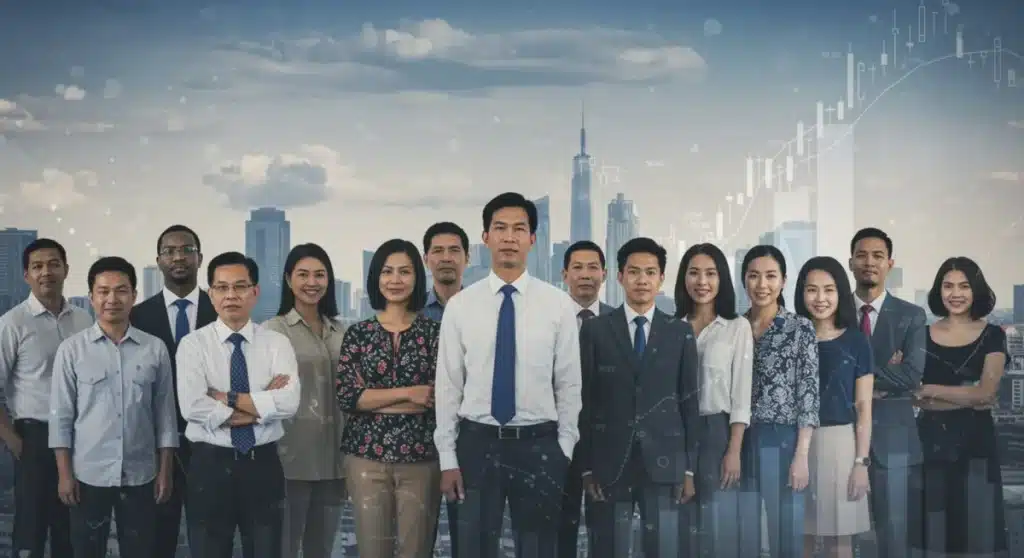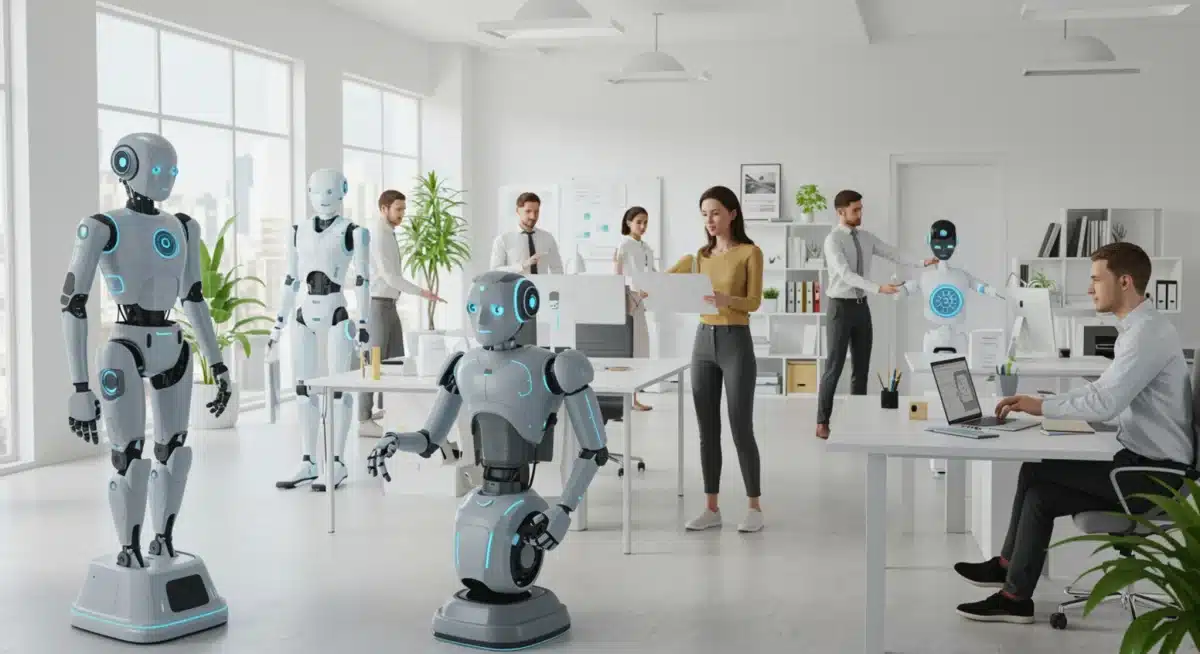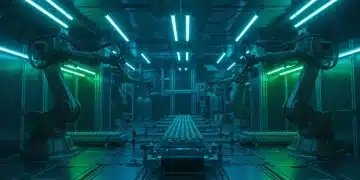Demographic Shifts: Impact on US Labor Force and Economic Output

Demographic shifts, including an aging population, declining birth rates, and evolving migration patterns, are fundamentally altering the composition and capabilities of the US labor force and economic output, necessitating strategic adaptations across various sectors.
Have you ever considered how the very fabric of our society – who we are, how old we are, and where we come from – directly influences our nation’s economic health? The intricate dance between population changes and economic performance is more profound than many realize. This article delves into How Demographic Shifts are Affecting the US Labor Force and Economic Output, exploring the profound implications of an evolving population landscape on America’s workplaces and its overall financial prosperity.
The Aging Workforce: A Looming Challenge
The United States is experiencing a significant demographic transformation: its population is getting older. This aging trend, driven by increased life expectancy and lower birth rates, has profound implications for the labor force. As a larger proportion of the population moves into retirement age, the pool of working-age individuals shrinks, creating a structural challenge for sustained economic growth.
This shift isn’t just about fewer workers; it’s also about a change in the composition of the workforce. Older workers bring invaluable experience and institutional knowledge, but they may also have different needs regarding workplace flexibility, healthcare, and retirement benefits. Understanding these nuances is critical for businesses and policymakers alike.
Impact on Labor Participation Rates
One of the most direct consequences of an aging population is its effect on labor force participation rates. As more individuals exit the workforce for retirement, the overall percentage of the population actively working or seeking employment tends to decline. This phenomenon can lead to labor shortages in various sectors, particularly those requiring specific skills or physical demands.
- Reduced Supply of Workers: Fewer young entrants and more retirees mean a smaller overall labor pool.
- Skill Gaps: The departure of experienced workers can create critical skill gaps that are difficult to fill quickly.
- Increased Dependency Ratio: A larger non-working elderly population places greater pressure on the working-age population to support social security and healthcare systems.
Productivity and Innovation Concerns
While older workers can be highly productive, a shrinking and aging workforce can raise concerns about aggregate productivity growth and innovation. Younger generations often bring new ideas, technological fluency, and entrepreneurial spirit. A relative decline in this demographic could potentially slow the pace of innovation and economic dynamism. However, it also presents an opportunity to leverage the wisdom and experience of older generations in new ways, fostering intergenerational collaboration.
The challenge lies in ensuring that the existing workforce, regardless of age, remains highly skilled and adaptable to new technologies. Investment in lifelong learning and reskilling programs becomes paramount to maintain productivity levels and drive innovation in an evolving economic landscape.
In conclusion, the aging workforce presents a multifaceted challenge to the US labor market, impacting participation rates, creating potential skill gaps, and raising questions about future productivity and innovation. Addressing these issues requires forward-thinking policies and strategic investments in human capital.
Shifting Birth Rates and Future Labor Supply
Beyond the aging of the current population, the United States has also experienced a notable decline in birth rates over recent decades. This trend, while seemingly distant in its immediate economic impact, is a crucial determinant of the future labor supply. Fewer births today mean fewer young adults entering the workforce 18 to 25 years from now, exacerbating the challenges posed by an aging population.
Several factors contribute to these declining birth rates, including economic uncertainty, changing societal norms regarding family size, increased educational and career opportunities for women, and the rising cost of raising children. These factors collectively paint a picture of a future where the inflow of new workers may not be sufficient to replace those retiring.
Long-Term Economic Consequences
The long-term economic consequences of sustained low birth rates are significant. A smaller future labor force implies reduced economic growth potential, as there will be fewer individuals to produce goods and services, innovate, and contribute to the tax base. This could lead to a less dynamic economy and place greater strain on public services designed to support an older population.
- Strained Social Security: Fewer young workers contributing to the system while more retirees draw benefits.
- Reduced Consumer Demand: A slower-growing or shrinking population can lead to dampened overall demand for goods and services.
- Fiscal Pressures: Governments may face challenges in funding public services with a smaller tax base relative to an increasing dependent population.
Policy Responses and Adaptations
Governments and businesses are increasingly recognizing the need for policy responses to mitigate the effects of declining birth rates. These can range from family-friendly policies designed to support parents and encourage childbearing, to strategies focused on maximizing the potential of the existing workforce and attracting skilled immigrants. Investing in early childhood education and affordable childcare are two examples of policies that could help ease the burden on young families.
Furthermore, businesses might need to adapt by investing more in automation and artificial intelligence to offset labor shortages, or by creating more flexible work environments to retain and attract talent from diverse demographics. The challenge is to find a balance that supports both economic vitality and societal well-being in the face of these demographic realities.
The trajectory of birth rates today will shape the economic landscape of tomorrow. Understanding and proactively addressing the implications of these trends is essential for ensuring a robust and resilient US economy in the decades to come.
Migration Patterns and Workforce Diversity
Immigration has historically played a vital role in shaping the US labor force, contributing significantly to its growth and diversity. As domestic birth rates decline and the population ages, migration patterns become an even more critical factor in sustaining economic output. Immigrants often fill labor gaps, bring diverse skills, and exhibit higher rates of entrepreneurship, all of which contribute positively to the economy.
The demographic profile of immigrants to the US has also evolved, with shifts in countries of origin and skill sets. This diversity enriches the labor market, bringing different perspectives, languages, and cultural insights that can foster innovation and expand market reach. However, integrating new populations effectively into the workforce requires supportive policies and societal structures.
Economic Contributions of Immigrants
Immigrants contribute to the US economy in multiple ways. They are disproportionately represented in certain sectors, such as agriculture, construction, and healthcare, often taking jobs that native-born workers are less willing to do. Furthermore, immigrants have higher rates of business formation, creating jobs and stimulating local economies. Their presence also helps to offset the effects of an aging native-born population, providing a younger demographic to support social security and contribute to the tax base.

- Filling Labor Gaps: Immigrants often take jobs in sectors facing shortages, from high-tech to low-skill.
- Entrepreneurship: They start businesses at higher rates, driving innovation and job creation.
- Demographic Rejuvenation: A younger average age among immigrants helps balance an aging native-born population.
- Tax Contributions: Immigrants contribute to the tax base, supporting public services and social programs.
Challenges and Integration
While the economic benefits of immigration are clear, challenges related to integration and policy also exist. Language barriers, recognition of foreign credentials, and access to education and training can hinder immigrants’ full participation in the labor force. Moreover, immigration policies themselves play a significant role in determining the quantity and skill mix of new arrivals, directly influencing their economic impact.
Effective integration strategies are crucial. These include providing language instruction, facilitating credential recognition, and offering pathways to citizenship. Policies that streamline legal immigration for skilled workers and address the needs of undocumented workers can also enhance the overall economic contribution of immigrant populations. The debate around immigration policy often centers on social and political concerns, but its economic implications for the US labor force and economic output are undeniable.
In summary, migration patterns are a critical dynamic in the US labor force, offering a powerful lever to counter the effects of an aging population and declining birth rates. Leveraging the full economic potential of immigrants requires thoughtful policies and effective integration strategies.
Technological Advancement and Automation
In the face of demographic shifts, particularly a shrinking labor pool, technological advancements like automation and artificial intelligence (AI) are emerging as crucial tools for maintaining and even boosting economic output. These technologies can augment human labor, perform repetitive tasks, and increase efficiency, potentially offsetting some of the challenges posed by fewer available workers. The relationship between demographics and technology is not one of simple replacement but rather a complex interplay of adaptation and evolution.
Automation can help industries cope with labor shortages by making existing workers more productive or by taking over tasks that are difficult to fill. This is particularly relevant in sectors like manufacturing, logistics, and even parts of the service industry. However, the integration of these technologies also raises important questions about job displacement, the need for new skills, and the future nature of work.
Automation as a Solution to Labor Shortages
For industries struggling to find enough workers, automation offers a compelling solution. Robots can perform tasks that are dangerous, monotonous, or require precision, freeing up human workers to focus on more complex, creative, or interpersonal roles. This can lead to increased output even with a stable or slightly shrinking workforce. The deployment of AI in data analysis, customer service, and other knowledge-based tasks further extends this capability, enhancing efficiency across various sectors.
- Increased Productivity: Machines can work faster and more consistently than humans in many tasks.
- Filling Unattractive Jobs: Automation can take over jobs that are difficult to staff due to physical demands or low appeal.
- Enhanced Quality and Precision: Robots and AI can reduce errors and improve the quality of goods and services.
Reskilling and the Future of Work
While automation offers significant benefits, it also necessitates a proactive approach to workforce development. As some jobs become automated, workers will need to acquire new skills to remain relevant in the evolving labor market. This requires substantial investment in education, training, and reskilling programs, both by individuals and by employers and governments. The focus should shift from performing routine tasks to managing technology, analyzing data, and engaging in critical thinking and problem-solving.
The future of work in an era of demographic shifts and technological advancement will likely involve a hybrid model, where humans and machines collaborate. This co-existence demands a flexible and adaptable workforce, capable of continuous learning. Policymakers must consider how to support workers through these transitions, ensuring that the benefits of technological progress are widely shared and that no segment of the population is left behind.
Ultimately, automation and AI are powerful tools that can mitigate the negative impacts of demographic shifts on the US labor force and economic output. Their successful integration hinges on strategic planning, investment in human capital, and a commitment to fostering an adaptable workforce.
Regional Disparities and Economic Impact
Demographic shifts do not impact all regions of the United States uniformly. There are significant regional disparities in population aging, birth rates, and migration patterns, leading to varied economic outcomes across different states and metropolitan areas. While some regions may experience rapid growth and an influx of young workers, others face an accelerated decline in their working-age population, creating uneven economic landscapes.
These regional differences can exacerbate existing inequalities and create new challenges for local economies. For example, rural areas often experience more pronounced aging and out-migration of young people, leading to labor shortages, declining tax bases, and reduced access to essential services. Conversely, vibrant urban centers might attract young professionals and immigrants, driving economic expansion but also facing issues like rising housing costs and infrastructure strain.
Uneven Distribution of Workforce Challenges
The uneven distribution of demographic challenges means that a one-size-fits-all policy approach is unlikely to be effective. Some states are already grappling with severe labor shortages in critical sectors, while others are still experiencing robust workforce growth. This divergence requires tailored strategies that consider the unique demographic and economic context of each region.

- Rural Decline: Many rural areas face a shrinking and aging population, leading to economic stagnation.
- Urban Growth: Major cities often attract younger populations and immigrants, fueling economic dynamism.
- Industry-Specific Impacts: Regions reliant on industries with specific labor needs will feel demographic shifts differently.
Policy Implications for Regional Development
Addressing regional disparities requires a concerted effort from federal, state, and local governments. Policies could include targeted investments in infrastructure and education in declining regions, incentives to attract businesses and young families, and support for remote work initiatives that can help distribute economic opportunities more widely. Additionally, fostering regional collaboration and sharing best practices can help areas learn from each other’s successes and challenges.
For example, some states are implementing programs to attract immigrants to specific rural areas to revitalize their economies and fill labor gaps. Others are focusing on developing local talent pipelines through vocational training and community college partnerships. The goal is to ensure that all regions have the opportunity to thrive, despite the differing demographic headwinds they may face. Recognizing and responding to these regional nuances is crucial for maintaining overall national economic stability and equitable growth.
In conclusion, demographic shifts create significant regional disparities in the US, demanding localized and flexible policy responses. Understanding these varied impacts is key to fostering balanced economic development across the nation.
Policy Responses and Future Outlook
The profound impact of demographic shifts on the US labor force and economic output necessitates comprehensive and proactive policy responses. Relying solely on market forces may not be sufficient to address the structural challenges posed by an aging population, declining birth rates, and evolving migration patterns. Policymakers face the complex task of designing interventions that promote economic growth, ensure social equity, and adapt to a changing demographic reality.
These policy responses must be multi-faceted, encompassing areas such as education, immigration, healthcare, and workforce development. They also require a long-term perspective, as demographic trends unfold over decades, and the effects of policy changes may not be immediately apparent. The goal is to build a resilient economy that can not only withstand these shifts but also harness new opportunities that arise from them.
Key Policy Levers
Several key policy levers can be utilized to address the challenges of demographic change. One crucial area is immigration reform, focusing on attracting skilled workers and streamlining legal pathways for those who can fill labor shortages. Another is investment in human capital, through lifelong learning initiatives, vocational training, and early childhood education, to ensure the workforce remains skilled and adaptable.
- Immigration Reform: Attracting and retaining skilled immigrants to bolster the labor force.
- Workforce Development: Investing in education, reskilling, and upskilling programs for all ages.
- Family-Friendly Policies: Supporting working parents through affordable childcare and parental leave to potentially mitigate declining birth rates.
- Retirement and Healthcare Reform: Adapting social security and healthcare systems to support an aging population.
- Automation Incentives: Encouraging businesses to adopt technologies that increase productivity and compensate for labor shortages.
Adapting to a New Economic Paradigm
The future outlook for the US economy, shaped by these demographic shifts, points towards a new paradigm. This paradigm will likely feature a more diverse and older workforce, increased reliance on technology, and a greater emphasis on flexibility and adaptability. Businesses will need to innovate not just in products and services, but also in how they manage talent, foster inclusive workplaces, and invest in their employees’ continuous development.
Government policies will play a crucial role in facilitating this adaptation, creating an environment where both workers and businesses can thrive. This includes fostering a culture of lifelong learning, ensuring access to affordable healthcare, and designing social safety nets that are robust enough to support a changing population. The challenge is immense, but with strategic planning and collaborative effort, the US can navigate these demographic waters and emerge with a stronger, more equitable, and more dynamic economy.
In conclusion, effective policy responses are paramount to managing the impact of demographic shifts on the US labor force and economic output. A forward-looking, multi-faceted approach is essential for building a resilient and prosperous future.
| Key Demographic Trend | Impact on US Economy |
|---|---|
| Aging Workforce | Reduced labor participation, potential skill gaps, increased dependency ratio. |
| Declining Birth Rates | Smaller future labor supply, strained social security, reduced long-term growth potential. |
| Migration Patterns | Fills labor gaps, boosts entrepreneurship, demographic rejuvenation, tax contributions. |
| Technological Advancement | Increases productivity, offsets labor shortages, requires workforce reskilling. |
Frequently Asked Questions About Demographic Shifts and the Economy
An aging population reduces the overall labor force participation rate as more people retire. This can lead to labor shortages in certain sectors, create skill gaps as experienced workers leave, and increase the dependency ratio, placing more pressure on younger generations to support social security and healthcare systems.
Declining birth rates lead to a smaller future labor supply, which can slow overall economic growth due to fewer producers and consumers. It also strains social security and public services, as a smaller working population supports a larger retired demographic, potentially leading to fiscal challenges.
Immigration can counteract negative demographic trends by replenishing the labor force, filling critical labor gaps, and contributing to a younger demographic profile. Immigrants also show higher rates of entrepreneurship, boosting innovation and job creation, and contributing significantly to the tax base and consumer demand.
Automation and AI can significantly mitigate labor shortages by increasing productivity and taking over repetitive tasks, freeing human workers for more complex roles. While they can’t fully replace human labor, they are crucial tools for maintaining economic output amidst demographic changes, provided there’s investment in workforce reskilling.
Rural areas often experience more pronounced aging and out-migration of young people, leading to severe labor shortages and economic stagnation. Conversely, some vibrant urban centers continue to attract young professionals and immigrants, driving growth but also facing issues like rising housing costs and infrastructure strain, creating significant regional disparities.
Conclusion
The demographic shifts currently underway in the United States represent one of the most significant long-term challenges and opportunities for its economy. An aging population and declining birth rates are fundamentally reshaping the labor force, necessitating strategic adaptations in how we approach work, productivity, and social support systems. However, these challenges are not insurmountable. Through thoughtful policy interventions in areas such as immigration, education, and technology adoption, the US can not only mitigate the potential negative impacts but also harness the strengths of a diverse and evolving population. The future of the US labor force and economic output will depend on our collective ability to anticipate these changes, innovate, and invest in a resilient and adaptable society.





